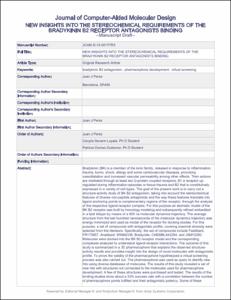Mostra el registre d'ítem simple
New insights into the stereochemical requirements of the bradykinin B2 receptor antagonists binding
| dc.contributor.author | Lupala, Cecylia Severin |
| dc.contributor.author | Gomez-Gutierrez, Patricia |
| dc.contributor.author | Pérez González, Juan Jesús |
| dc.contributor.other | Universitat Politècnica de Catalunya. Departament d'Enginyeria Química |
| dc.date.accessioned | 2016-05-17T09:57:55Z |
| dc.date.available | 2017-01-03T01:30:32Z |
| dc.date.issued | 2016-01-20 |
| dc.identifier.citation | S. Lupala, C., Gomez-Gutierrez, P., Perez, J. New insights into the stereochemical requirements of the bradykinin B2 receptor antagonists binding. "Journal of computer-aided molecular design", 20 Gener 2016, vol. 30, núm. 1, p. 85-101. |
| dc.identifier.issn | 0920-654X |
| dc.identifier.uri | http://hdl.handle.net/2117/87094 |
| dc.description.abstract | Bradykinin (BK) is a member of the kinin family, released in response to inflammation, trauma, burns, shock, allergy and some cardiovascular diseases, provoking vasodilatation and increased vascular permeability among other effects. Their actions are mediated through at least two G-protein coupled receptors, B1 a receptor up-regulated during inflammation episodes or tissue trauma and B2 that is constitutively expressed in a variety of cell types. The goal of the present work is to carry out a structure–activity study of BK B2 antagonism, taking into account the stereochemical features of diverse non-peptide antagonists and the way these features translate into ligand anchoring points to complementary regions of the receptor, through the analysis of the respective ligand-receptor complex. For this purpose an atomistic model of the BK B2 receptor was built by homology modeling and subsequently refined embedded in a lipid bilayer by means of a 600 ns molecular dynamics trajectory. The average structure from the last hundred nanoseconds of the molecular dynamics trajectory was energy minimized and used as model of the receptor for docking studies. For this purpose, a set of compounds with antagonistic profile, covering maximal diversity were selected from the literature. Specifically, the set of compounds include Fasitibant, FR173657, Anatibant, WIN64338, Bradyzide, CHEMBL442294, and JSM10292. Molecules were docked into the BK B2 receptor model and the corresponding complexes analyzed to understand ligand-receptor interactions. The outcome of this study is summarized in a 3D pharmacophore that explains the observed structure–activity results and provides insight into the design of novel molecules with antagonistic profile. To prove the validity of the pharmacophore hypothesized a virtual screening process was also carried out. The pharmacophore was used as query to identify new hits using diverse databases of molecules. The results of this study revealed a set of new hits with structures not connected to the molecules used for pharmacophore development. A few of these structures were purchased and tested. The results of the binding studies show about a 33 % success rate with a correlation between the number of pharmacophore points fulfilled and their antagonistic potency. Some of these structures are disclosed in the present work. |
| dc.format.extent | 17 p. |
| dc.language.iso | eng |
| dc.rights.uri | http://creativecommons.org/licenses/by-nc-nd/3.0/es/ |
| dc.subject | Àrees temàtiques de la UPC::Enginyeria química |
| dc.subject.lcsh | Bradykinin--Antagonists |
| dc.subject.other | Bradykinin B2 antagonism |
| dc.subject.other | Pharmacophore development |
| dc.subject.other | Virtual screening |
| dc.title | New insights into the stereochemical requirements of the bradykinin B2 receptor antagonists binding |
| dc.type | Article |
| dc.subject.lemac | Proteïnes G -- Receptors |
| dc.contributor.group | Universitat Politècnica de Catalunya. GBMI - Grup de Biotecnologia Molecular i Industrial |
| dc.identifier.doi | 10.1007/s10822-015-9890-z |
| dc.description.peerreviewed | Peer Reviewed |
| dc.relation.publisherversion | http://link.springer.com/article/10.1007%2Fs10822-015-9890-z |
| dc.rights.access | Open Access |
| local.identifier.drac | 17841298 |
| dc.description.version | Postprint (author's final draft) |
| local.citation.author | S. Lupala, C.; Gomez-Gutierrez, P.; Perez, J. |
| local.citation.publicationName | Journal of computer-aided molecular design |
| local.citation.volume | 30 |
| local.citation.number | 1 |
| local.citation.startingPage | 85 |
| local.citation.endingPage | 101 |
Fitxers d'aquest items
Aquest ítem apareix a les col·leccions següents
-
Articles de revista [190]
-
Articles de revista [2.226]



